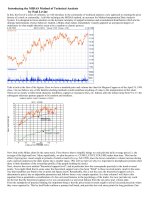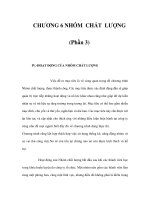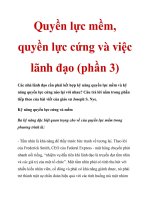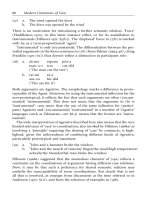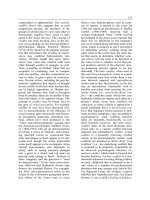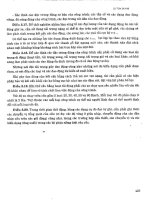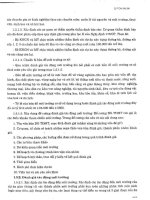Foundations of Technical Analysis phần 3 potx
Bạn đang xem bản rút gọn của tài liệu. Xem và tải ngay bản đầy đủ của tài liệu tại đây (826.88 KB, 10 trang )
(a) Double Top
(b) Double Bottom
Figure 7. Double tops and bottoms.
Foundations of Technical Analysis 1725
III. Is Technical Analysis Informative?
Although there have been many tests of technical analysis over the years,
most of these tests have focused on the profitability of technical trading
rules.
9
Although some of these studies do find that technical indicators can
generate statistically significant trading profits, but they beg the question
of whether or not such profits are merely the equilibrium rents that accrue
to investors willing to bear the risks associated with such strategies. With-
out specifying a fully articulated dynamic general equilibrium asset-pricing
model, it is impossible to determine the economic source of trading profits.
Instead, we propose a more fundamental test in this section, one that
attempts to gauge the information content in the technical patterns of Sec-
tion II.A by comparing the unconditional empirical distribution of returns
with the corresponding conditional empirical distribution, conditioned on the
occurrence of a technical pattern. If technical patterns are informative, con-
ditioning on them should alter the empirical distribution of returns; if the
information contained in such patterns has already been incorporated into
returns, the conditional and unconditional distribution of returns should be
close. Although this is a weaker test of the effectiveness of technical analy-
sis—informativeness does not guarantee a profitable trading strategy—it is,
nevertheless, a natural first step in a quantitative assessment of technical
analysis.
To measure the distance between the two distributions, we propose two
goodness-of-fit measures in Section III.A. We apply these diagnostics to the
daily returns of individual stocks from 1962 to 1996 using a procedure de-
scribed in Sections III.B to III.D, and the results are reported in Sec-
tions III.E and III.F.
A. Goodness-of-Fit Tests
A simple diagnostic to test the informativeness of the 10 technical pat-
terns is to compare the quantiles of the conditional returns with their un-
conditional counterparts. If conditioning on these technical patterns provides
no incremental information, the quantiles of the conditional returns should
be similar to those of unconditional returns. In particular, we compute the
9
For example, Chang and Osler ~1994! and Osler and Chang ~1995! propose an algorithm for
automatically detecting head-and-shoulders patterns in foreign exchange data by looking at
properly defined local extrema. To assess the efficacy of a head-and-shoulders trading rule, they
take a stand on a class of trading strategies and compute the profitability of these across a
sample of exchange rates against the U.S. dollar. The null return distribution is computed by a
bootstrap that samples returns randomly from the original data so as to induce temporal in-
dependence in the bootstrapped time series. By comparing the actual returns from trading
strategies to the bootstrapped distribution, the authors find that for two of the six currencies
in their sample ~the yen and the Deutsche mark!, trading strategies based on a head-and-
shoulders pattern can lead to statistically significant profits. See, also, Neftci and Policano
~1984!, Pruitt and White ~1988!, and Brock et al. ~1992!.
1726 The Journal of Finance
deciles of unconditional returns and tabulate the relative frequency Zd
j
of
conditional returns falling into decile j of the unconditional returns, j ϭ
1, ,10:
Zd
j
[
number of conditional returns in decile j
total number of conditional returns
. ~15!
Under the null hypothesis that the returns are independently and identi-
cally distributed ~IID! and the conditional and unconditional distributions
are identical, the asymptotic distributions of Zd
j
and the corresponding goodness-
of-fit test statistic Q are given by
!
n~ Zd
j
Ϫ 0.10!;
a
N
~
0,0.10~1 Ϫ 0.10!
!
, ~16!
Q [
(
jϭ1
10
~n
j
Ϫ 0.10n!
2
0.10n
;
a
x
9
2
, ~17!
where n
j
is the number of observations that fall in decile j and n is the total
number of observations ~see, e.g., DeGroot ~1986!!.
Another comparison of the conditional and unconditional distributions of
returns is provided by the Kolmogorov–Smirnov test. Denote by $Z
1t
%
tϭ1
n
1
and
$Z
2t
%
tϭ1
n
2
two samples that are each IID with cumulative distribution func-
tions F
1
~z! and F
2
~z!, respectively. The Kolmogorov–Smirnov statistic is de-
signed to test the null hypothesis that F
1
ϭ F
2
and is based on the empirical
cumulative distribution functions
Z
F
i
of both samples:
Z
F
i
~z